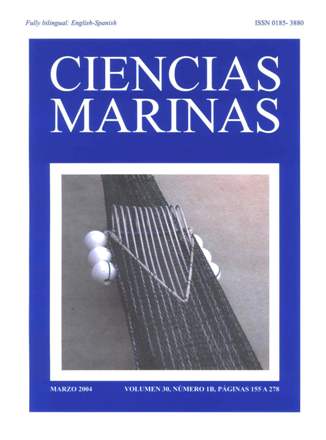Sodium and potassium alginates extracted from Macrocystis pyrifera algae for use in dental impression materials
Main Article Content
Abstract
Sodium and potassium alginates were extracted at the pilot plant scale from the giant kelp, Macrocystis pyrifera, from Bahía Tortugas, Baja California Sur, Mexico. Alginates were coded as S1, S2 and S3 for sodium alginate, and as P1, P2 and P3 for potassium alginate. The average viscosities of the sodium and potassium alginates in aqueous 1% solution were 58, 145 and 506 mPa s, and 48, 155 and 200 mPa s, respectively. Results showed that dental impresion material prepared with sodium alginate with extra low viscosities (S1 = 58 mPa s) and low viscosities (S2 = 145 m Pa s) did not form gels, the material prepared with medium viscosity (S3 = 506 mPa s) produced a gel type II (regular set) in 70% of the 10 formulations experimented, and the material prepared with potassium alginate with extra low viscosity (P1 = 48 mPa s) produced a gel type II in 90% of the formulations. Using potassium alginate with low viscosity (P2 = 155 mPa s), 90% of the formulations were type I (fast set), and using potassium alginate with medium viscosity (P3 = 200 mPa s), 80% of the formulations were type I. The highest compressive strength was obtained using sodium alginate of 506 mPa s and the three potassium alginates experimented at 25% concentration, with values of 2474, 1209, 2101 and 2124 g cm–2 for S3, P1, P2 and P3 alginates, respectively. The elasticity order of formulation with 25% alginates compared with a commercial product (Jeltrate®) was as follows: Jeltrate® > P2 > S3 > P3 > P1. It was concluded that S3, P1, P2 and P3 alginates have good potential for use in the production of dental impression materials.
Downloads
Article Details
This is an open access article distributed under a Creative Commons Attribution 4.0 License, which allows you to share and adapt the work, as long as you give appropriate credit to the original author(s) and the source, provide a link to the Creative Commons license, and indicate if changes were made. Figures, tables and other elements in the article are included in the article’s CC BY 4.0 license, unless otherwise indicated. The journal title is protected by copyrights and not subject to this license. Full license deed can be viewed here.

